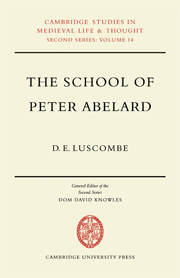Book contents
- Frontmatter
- Contents
- Preface
- List of Abbreviations
- I The Literary Evidence
- II Abelard's Followers
- III The Diffusion of Abelardian Writings
- IV The Condemnation of 1140
- V The Theological Writings of Abelard's Closest Disciples
- VI The School of Laon
- VII Hugh of St Victor
- VIII The Summa Sententiarum
- IX Abelard and the Decretum of Gratian
- X Abelard's Disciples and the School of St Victor
- XI Peter Lombard
- XII Robert of Melun
- XIII Richard of St Victor
- XIV Conclusion
- Appendices
- Bibliography
- Index of Manuscripts
- General Index
V - The Theological Writings of Abelard's Closest Disciples
Published online by Cambridge University Press: 05 November 2011
- Frontmatter
- Contents
- Preface
- List of Abbreviations
- I The Literary Evidence
- II Abelard's Followers
- III The Diffusion of Abelardian Writings
- IV The Condemnation of 1140
- V The Theological Writings of Abelard's Closest Disciples
- VI The School of Laon
- VII Hugh of St Victor
- VIII The Summa Sententiarum
- IX Abelard and the Decretum of Gratian
- X Abelard's Disciples and the School of St Victor
- XI Peter Lombard
- XII Robert of Melun
- XIII Richard of St Victor
- XIV Conclusion
- Appendices
- Bibliography
- Index of Manuscripts
- General Index
Summary
The circle of Abelard's followers or of those scholars who actually wrote treatises or commentaries under Abelard's impulsion and who closely followed his teaching was small. As a productive force in the literature of the twelfth century it ceased to exist within a decade or a little more of Abelard's death. It is probably realistic to distinguish between those students of Abelard who wrote up his teaching while in his school or shortly after leaving it and other clerics or monks who drew upon Abelard's material and who even did so after his departure from the schools and after his final condemnation. In spite of the size of Abelard's following in his lifetime, no term was coined in the twelfth century in corporate designation of these disciples as was the case with the porretani and it is possible, though undemonstrable, that the need for such a classification was greatly lessened by Abelard's death and by the effects of the condemnation. In the following pages the fortunes of Abelard's most controverted opinions will be traced through the writings of his closest disciples as well as of other authors outside his school or formed by other traditions of teaching than that of Abelard alone but who gave a full consideration to Abelard's thought. The posthumous influence of Abelard's teaching is, however, too diffuse to be discussed at all adequately by this means; particular aspects can best be appreciated by the attentive study of the history of single ideas or themes as they have been treated already in many cases by such doctrinal historians as O. Lottin in numerous chapters of his Psychologie et Morale, and L. Ott on many pages of his admirable Untersuchungen.
- Type
- Chapter
- Information
- The School of Peter AbelardThe Influence of Abelard's Thought in the Early Scholastic Period, pp. 143 - 172Publisher: Cambridge University PressPrint publication year: 1969

